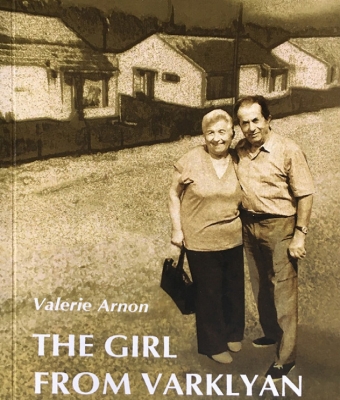The Girl From Varklyan
The Girl From Varklyan: Memories of a migrant
By Valerie Arnon
Jerusalem, 2020, Paperback, 250 pages
Reviewed by Carol Cook
In the course of reading The Girl from Varklyan, I sometimes wondered whether Hana, who tells the story, had the gift of total recall or was mainly a talented storyteller. Science, after all, has not yet decided whether human memory is accurate or extremely unreliable. But it really doesn't matter. Hana's biography, told in a monologue, is a compelling read, and an inspiration as well.
Hana was a young teacher in Riga in July 1941, as the Nazi army was completing its occupation of Latvia. Unable even to say goodbye to her parents, she fled toward Russia with her cousin Hana Bluma. They boarded a train packed with refugees with only the clothes they wore and a bag containing some cucumbers and sugar.
The two young women crossed the border and wandered from one town and village to another for four long years, searching for food, shelter and work wherever they could find it.
Hana tells the story in meticulous detail, starting with memories from her infancy. She describes her childhood in the shtetl of Varklyan, with its vibrant Jewish community; her teenage romances, her studies and work as a teacher.
After her last-minute escape from the Nazis, she had only her wits and intuition to save herself and her cousin. We learn how she does it day after day – trudging through the snow to find a supply of potatoes, washing and drying her one set of clothes, finding work in a prison camp, and tracking down some relatives who take the two cousins in. Ordinary actions, but heroic ones.
At the conflict's end, Hana returned to her shtetl, finding it totally destroyed, and learned of the tragic fate of her parents and indeed of the whole of Latvian Jewry. There were more than 20,000 Jews in Riga when the Germans seized the city: fewer than 150 survived.
Hana and her husband Yosef, who met during the war years, lived under the Soviet regime afterward, and made their way to Israel in 1957. They settled in Nof Yam, now an upscale neighborhood of Herzliya, but then a modest development for new arrivals from Europe and North Africa.
Valerie Arnon, an author and literary translator from England, lived there, too, and she had begun to document her neighbors' immigrant experiences. Their friendship began when Hana became Valerie's Yiddish teacher. When they started meeting for lessons and Hana spoke of her past, Arnon decided to record the story. She likens Hana's prodigious memory to "a tree laden with juicy pomegranates only waiting to be picked".
Her conversations with Hana and Yosef spanned two years, and Arnon eventually published them in the anthology Across the Street and Far Away which includes the oral histories of several other Nof Yam residents.
Now Hana's story is available on its own in a new paperback edition. It's told as a long monologue, mainly by Hana, with Yosef adding his own memories from time to time. With two speakers, I found this format a bit confusing; dividing the text into shorter chapters and adding more subtitles might have made the story easier to follow.
I would also have liked to see some intervention by Arnon herself, who might have offered her personal perspective on being a neighborhood historian and a comparison of Hana's story with others she recorded – as well as her own immigrant experience.
Still, there is much to reward the reader. With their vivid recollections, Hana and Yosef offer us a message of resilience and survival that is universal and still relevant. With a tragic migrant crisis unfolding in our daily news reports, the struggles and survival of these two courageous people from the past seem as fresh and full of hope as though they were happening today.
More information is available at www.valarnon.com .
Carol Cook is a writer and editor.








Comments